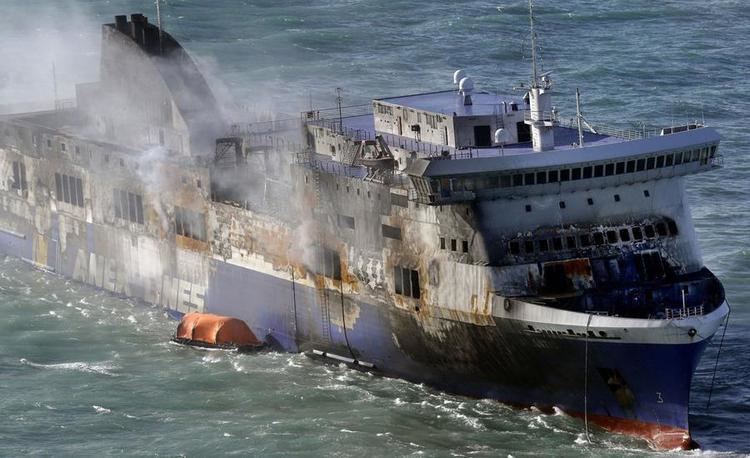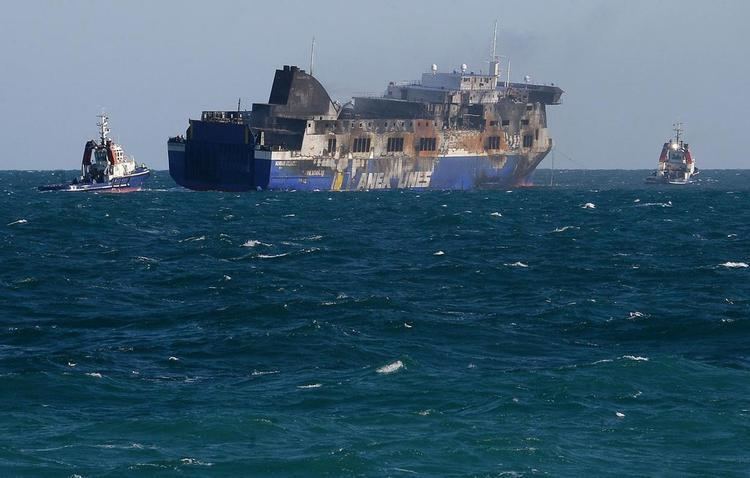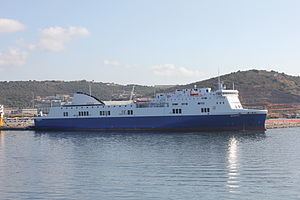Length 186 m Draft 6.71 m | Ordered 1 November 2006 Construction started 19 December 2006 Beam 26 m | |
 | ||
Name Akeman Street (2009–2011)Scintu (2011–2014)Norman Atlantic (since 2014) Owner Visemar di Navigazione S.r.l. (2009 onwards) Operator Saremar (2011–2012)Grandi Navi Veloci (2013)Moby Lines (2013)LD Lines (2013–2014)Caronte and Tourist (October–December 2014)ANEK Lines (since December 2014) Builders Cantiere Navale Visentini, Italy | ||
Ms norman atlantic in the port of bari italy
MS Norman Atlantic is a roll-on/roll-off passenger (ROPAX) ferry owned by the Italian ferry company Visemar di Navigazione. The ferry was chartered by ANEK Lines from December 2014. On 28 December 2014, she caught fire in the Strait of Otranto, in the Adriatic Sea. The bodies of nine victims (three Greek, two Italian, two German, a Georgian and a Turkish passenger) were recovered from the sea, while nineteen others (nine Greek, four Turkish, two Italian and a German passenger and two Syrian and one Iraqi stowaways) remain missing. Additionally, two crewmembers of the Albanian tug Iliria were killed during the salvage operations on 30 December. According to ANEK Lines, the total number of passengers and crew, based on the ship's manifest, was 475. As of 31 December, reports indicate that 499 people were on board the ferry, including 55 crew members; this figure excludes possible stowaways who were on board. On 29 November 2014 another of ANEK Lines ferries, the Ierapetra L, caught fire shortly after leaving the port of Brindisi, Italy; there were no passengers on board when the fire broke out and there were no casualties.
Contents
- Ms norman atlantic in the port of bari italy
- Description
- Usage history
- Incident
- Rescue
- Investigations
- References

Description

The ship is 186 metres (610 ft 3 in) long, with a beam of 25.6 metres (84 ft 0 in) and a draught of 6.71 metres (22 ft 0 in). She is powered by two MAN B&W 9L48/60B diesel engines, which can propel the ship at 24 knots (44 km/h).
Usage history

The ship was built in 2009 by Cantiere Navale Visentini, Porto Viro, Italy as Akeman Street for Ermine Street Shipping Co Ltd, London, United Kingdom. Her sister ships are Dimonios, Étretat, Norman Asturias, Scottish Viking and Stena Flavia. She has accommodation for 850 passengers and 2,286 lane metres of accommodation for vehicles. Between February and April 2010, she was chartered to T-Link. Following a refit in May 2011 at Valletta, Malta, she was chartered to Saremar and renamed Scintu in June 2011. In January 2013, she was chartered to Grande Navi Veloci, followed by a charter to Moby Lines in April 2013. In October 2013, Scintu was chartered to LD Lines. She was renamed Norman Atlantic in January 2014. On 29 August 2014, she made her final voyage with LD Lines, from Rosslare, County Wexford, Ireland to Saint-Nazaire, Loire-Atlantique, France and Gijón, Asturias, Spain. In September 2014, she was chartered to Caronte & Tourist, followed by a charter to ANEK Lines in December 2014.
Incident

On 28 December 2014, Norman Atlantic caught fire in the Strait of Otranto, on a ferry run from Patras to Ancona. A fire broke out on the car deck just before 6:00 am local time, half an hour after leaving port of Igoumenitsa, Greece, an intermediate stop, when she was 44 nautical miles (81 km) northwest of the island of Corfu, 33 nautical miles (61 km) northwest of the island of Othonoi. At the time she was carrying 222 vehicles, 487 passengers, and 55 crew. The heat from the fire permeated the entire ship, even starting to melt people's shoes on the reception deck. The incident happened in Greek territorial waters but with night closing in, the ship started drifting towards Albania. There were gale-force winds and lashing rain.

Passengers assert that the order to abandon ship was not given until four hours after the fire had started. Despite their cabins filling with smoke, no alarm had sounded. They also state that the crew of Norman Atlantic gave them little assistance. One group of 49 managed to escape in a lifeboat, but others were prevented from doing so as two of the four lifeboats were destroyed by the fire. The lifeboats had a capacity of 160 people each. Survivors described "scenes from hell" on board the burning ship, with the ship's crew overwhelmed by the crisis and jungle law prevailing rather than an orderly evacuation. Those in the lifeboat were rescued by the Singapore-registered container ship Spirit of Piraeus and landed at Bari, Italy. Several liferafts were also launched, but some of them capsized, causing the deaths by drowning or hypothermia of several occupants. The merchant ship Aby Jeannette rescued 39 people from Norman Atlantic's liferafts and brought them to Taranto, and the tanker Genmar Argus rescued a Norman Atlantic crewmember from the sea. Other people in the sea or in the rafts were rescued by helicopters.
Rescue

An international rescue effort, led and coordinated by the Italian Coast Guard, was started to evacuate the 466 passengers and crew on board. Greek Defence Minister Nikos Dendias stated that Italian authorities had responded to a Greek request for assistance and that the Italian Coast Guard had assumed control of the rescue operation. The Italian ferry Cruise Europa rescued 69 passengers and brought them to Igoumenitsa. Italian Prime Minister Matteo Renzi said that first passengers were rescued by a helicopter and that his government was working with the Greek government. As darkness fell on 28 December, the Italian Navy said that a tugboat, Marietta Barretta, had finally been able to attach a line to the ferry. Greek Marine Minister Miltiadis Varvitsiotis confirmed the towing operation but said he did not know the destination of the tugboat; although Albania was "much closer", he said the final decision rested with the Italian rescuers who "know the situation better". Prime Minister Renzi informed reporters that the ferry was evacuated and that Captain Giacomazzi was the last one to leave the ship at 2.50pm.
At least twelve people were killed as a direct result of the fire, and an additional two Albanian tugboat crewmembers were killed during salvage operations on 30 December when a connecting cable snapped. Eight people were injured in the original incident. Officials stated that one person died after jumping from the burning ship. A 62-year-old Greek man was the first of the fatalities to be recovered. On 30 December the number of people on board the ferry was revised to 499; 487 passengers and 12 crew. The number of people unaccounted for was revised to 179 by Italian authorities. On 1 January 2015 the number of people not accounted for was 98 according to the Italian prosecutor Giuseppe Volpe, but according to the Greek Merchant Marine Ministry 18 people were still missing. On 3 January 2015 Mr. Volpe said that the number of unaccounted persons from the fire was 10 to 15, while Greek authorities said the number was up to 19, including nine Greek men. Three of the rescued people who were on board the Norman Atlantic were Afghan illegal immigrants who stowed aboard in lorries in the hold. Judge Volpe said that he expected that more bodies were to be found on the ferry. Among those killed was Ilia Kartozia, a Georgian Orthodox priest, who, according to an eyewitness, helped other to evacuate, but the rescuers failed to save him. His body was recovered off Lecce on 30 December 2014.
Norman Atlantic was towed to the port of Brindisi, Italy, arriving there on 2 January 2015. The ship has been sequestered for the investigation. On 6 January, a lifeboat from the Norman Atlantic was found on a beach near Valona, Albania. The Norman Atlantic continued to burn in port for almost two weeks until 10 January 2015, when firefighters were finally able to enter the hull for inspection.
On 15 January 2015 the Italian authorities announced that 9 people from the Norman Atlantic (in addition to the two from the tug Iliria) were confirmed dead and 18 were missing. On 23 January it was announced that one more person was missing. On 4 February, it was announced that the death toll was now twelve dead, with eighteen still missing. On 13 February 2015, just before the boat was due to be towed to Bari, a second body was discovered in the truck parking area. In the same days, the bodies of three people, presumably belonging to some of the missing, were found on the coast of Corfu and Apulia. As of 14 February 2017, the boat is docked in the port of Bari.
Investigations
Italian authorities opened a criminal investigation into the fire. The investigation would determine whether or not criminal negligence played a part in the fire. Judge Giuseppe Volpe is in charge of the investigation, which could bring charges of culpable shipwreck. The ship had been inspected at Patras, Greece on 19 December; six serious deficiencies had been found, relating to emergency lighting, fire doors and lifesaving capacity on board the vessel. The owners had been served with a notice giving them fifteen days to remedy the deficiencies. On 2 January 2015 the prosecutor’s office in Bari widened the investigation, and put two other crew members and two representatives of the Greek ferry line ANEK Lines, which chartered the Norman Atlantic, under investigation.
Greek authorities have also started a preliminary investigation. Possible charges include "disruption of shipping which could lead to endangerment of persons", and arson.
Rear Admiral John Lang, formerly Chief Inspector at Britain's Marine Accident Investigation Branch, said the emergency, under freezing stormy conditions at night “challenges many of the established conventions and wisdom on how a mass rescue should be conducted.” He said that, in the course of the investigation, the right rather than the convenient conclusions should be drawn, adding "Rarely has the outcome of a comprehensive and thorough investigation been more important for improving safety at sea."
A Turkish passenger reported, as a possible cause, that illegal Afghan immigrants, who had boarded the ship concealed in a lorry, had lit a fire at the ship's garage to keep themselves warm. Another possible cause is sparks caused by trucks scraping the sides of the vessel.
Preliminary underwater inspections of the Norman Atlantic revealed that the water intake pipes of the fire sprinkler system were clogged with mussels; additional inspections are necessary to determine if this blockage contributed to the fire's spreading. Although the voyage data recorder (black box) has been recovered, still by mid-March no data have been extracted, apparently because the heat of the fire caused the plastic to melt onto the hard disk. Recordings of the Voyage data recorder published on 7 October 2015, say that the fire sprinkler system wasn't working correctly and instead of spraying water there was smoke coming from the system. The investigations also state that there was a truck that had the engine working. Smoke was coming from the truck prior to the fire.
